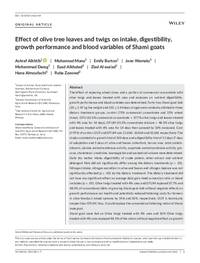Effect of olive tree leaves and twigs on intake, digestibility, growth performance and blood variables of Shami goats

Authors:
The effect of replacing wheat straw and a portion of commercial concentrate with olive twigs and leaves treated with urea and molasses on nutrient digestibility, growth performance and blood variables was determined. Forty‐two Shami goat kids (20 ± 2.47 kg live weight and 133 ± 5.44 days of age) were randomly allotted to three dietary treatment groups, control (75% commercial concentrate and 25% wheat straw), OTU (62.3% commercial concentrate + 37.7% olive twigs and leaves treated with 4% urea for 14 days), OTUM (51.5% concentrate mixture + 48.5% olive twigs and leaves treated with 4% urea for 14 days then sprayed by 10% molasses). Cost (SYP/t) of control, OUT and OTUM was 12,600, 10,066 and 10,106 respectively. The study consisted of a growth trial of 100 days and a digestibility trial of 12 days (7 days of adaptation and 5 days of urine and faeces collection). Serum urea, total protein, albumin, alanine aminotransferase activity, aspartate aminotransferase activity, glucose, cholesterol, creatinine, haemoglobin and packed cell volume were determined. Daily dry matter intake, digestibility of crude protein, ether extract and nutrient detergent fibre did not significantly differ among the dietary treatments (p > .05). Nitrogen intake, nitrogen excretion in urine and faeces and nitrogen balance was not significantly affected (p > .05) by the dietary treatment. The dietary treatment did not have any significant effect on average daily gain, feed conversion ratio or blood variables (p > .05). Olive twigs treated with 4% urea and OTUM replaced 37.7% and 48.5% of conventional diets of growing Shami goat kids without negative effects on growth performance nor health and potentially reduced fattening costs for farmers in olive‐livestock mixed systems by 19.8 and 20%, respectively. OUT is technically simpler than OTUM, thus, it could replace the conventional fattening ration of Shami male goat
